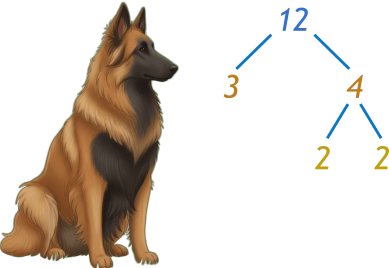Fundamental Theorem of Arithmetic

The Basic Idea is that any integer above 1 is either a Prime Number, or can be made by multiplying Prime Numbers together. Like this:
This continues on:
- 10 is 2×5
- 11 is Prime,
- 12 is 2×2×3
- 13 is Prime
- 14 is 2×7
- 15 is 3×5
- 16 is 2×2×2×2
- 17 is Prime
- and so on...
So they are either prime, or primes multiplied together
Read on for an explanation ...
The Fundamental Theorem of Arithmetic
Let us start with the definition:
Any integer greater than 1 is either a prime number, or can be written as a unique product of prime numbers (ignoring the order).
What does it mean?
Let's build up the ideas piece by piece:
"Any integer greater than 1" means the numbers 2, 3, 4, 5, 6, ... and so on.
A Prime Number is a whole number above 1 that cannot be made by multiplying other whole numbers.
The first few prime numbers are 2, 3, 5, 7, 11, 13, 17, 19, 23, ... (and more)
"...product of prime numbers" means that we multiply prime numbers together.
Example: 42
Is 42 prime, or can we make it by multiplying only prime numbers? Let's see:
2 × 3 × 7 = 42
Yes, 2, 3 and 7 are prime numbers, and when multiplied together they make 42.
Try some other examples for yourself. How about 30? Or 33?
"... unique product of prime numbers" means there is only one (unique!) set of prime numbers that will work
Example: we just showed that 42 is made by the prime numbers 2, 3 and 7:
2 × 3 × 7 = 42
No other prime numbers will work!
We could try 2 × 3 × 5, or 5 × 11, but none of them will work:
Only 2, 3 and 7 make 42
Repeated Numbers
We may have to repeat a prime number.
Example: 12 is made by multiplying the prime numbers 2, 2 and 3 together.
12 = 2 × 2 × 3
That is OK. In fact we can write it like this (using exponents):
12 = 22 × 3
It is still a unique combination (2, 2 and 3)
(Note: 4 × 3 is not right, as 4 is not a prime number)
Factor Trees
A factor tree can help us find the prime factors of a number.
We start with our number, then break it into any of its factors. If a factor is not prime, we keep breaking it down until only primes are left.
Example: 48
Let's break 48 into two factors:
48 = 8 × 6
No primes yet, let's continue breaking them into smaller parts:
8 = 4 × 2
6 = 2 × 3
And 4 can still be broken into 2 × 2. Now we have all primes:
48 = 2 × 2 × 2 × 2 × 3
And here is our factor tree:
And no matter which factors we start with, we always end up with the same set of prime numbers!
Let's try starting with 48 = 4 × 12 instead:
We still end up with the same primes
This shows the Fundamental Theorem of Arithmetic in action: the numbers may branch out in different ways, but we always reach the same unique prime factors in the end.
So there you have it!
Any of the numbers 2, 3, 4, 5, 6, ... and so on are either prime numbers, or can be made by multiplying prime numbers together.
And there is only one (unique) set of prime numbers that works in each case.
More examples:
Example: 7
7 is already a prime number
Example: 22
22 can be made by multiplying the prime numbers 2 and 11 together.
2 × 11 = 22
No other combination of prime numbers will work.
Ignore the Order
Also, at the top I said "ignoring the order". By that I mean:
- 2 × 11 = 22 is the same as
- 11 × 2 = 22
So don't just rearrange the numbers and say "it isn't unique", OK?
The First Few
|
2 |
Is a Prime |
|
3 |
Is a Prime |
|
4 |
= 2×2 = 22 |
|
5 |
Is a Prime |
|
6 |
= 2×3 |
|
7 |
Is a Prime |
|
8 |
= 2×2×2 = 23 |
|
9 |
= 3×3 = 32 |
|
10 |
= 2×5 |
|
11 |
Is a Prime |
|
12 |
= 2×2×3 = 22×3 |
|
13 |
Is a Prime |
|
14 |
= 2×7 |
|
... |
... |
Why not continue this list to 100 yourself?
Summary
The Fundamental Theorem of Arithmetic is like a "guarantee"
that any integer greater than 1 is either prime
or can be made by multiplying primes
and
There is only one way to do that in each case